Quick introduction to Portuguese wine (and Portugal’s wine regions)
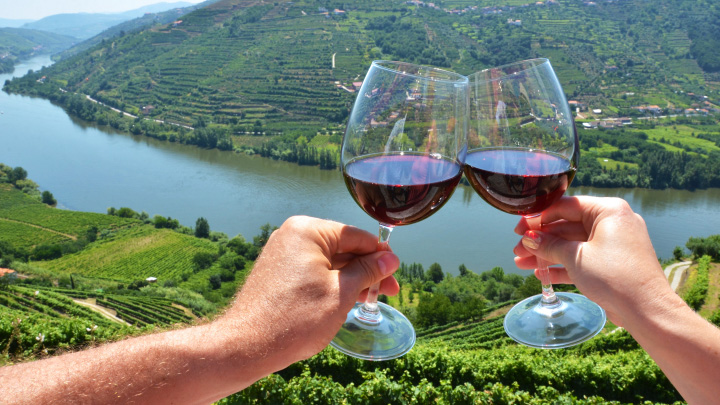
In recent years, Portuguese wine has grown in popularity around the world, while also more and more travelers with a keen interest in gastronomy and wine keep visiting our country. When you think of wine from Portugal beyond our borders, chances are the first reference that comes to mind is Port wine. This fortified wine from the Douro region has indeed been a great ambassador of wines from Portugal, but it’s just the tip of the iceberg when it comes to the world of winemaking in our country.
Vineyards have been planted in this region for more than 4000 years and, right now, Portugal is the 11th largest wine producer in the world. Considering that the Portuguese territory is quite small, this is quite an accomplishment. There’s no doubt that wine is an integral part of our diet and even socializing habits, and that’s how we manage to reach an average consumption of 72 bottles of wine per person per year!
If you know little about Portuguese wine, we’d be delighted to introduce you to this magnificent world in any of our food & cultural walks in Lisbon. Here, with us, you’ll have a chance to appreciate some notable examples of wines produced in our country. But if you are at home and would still like to learn more about Portuguese wine, in order to do a more mindful tasting next time, we recommend you keep reading to understand a little more about Portugal’s wine regions and grape varieties.
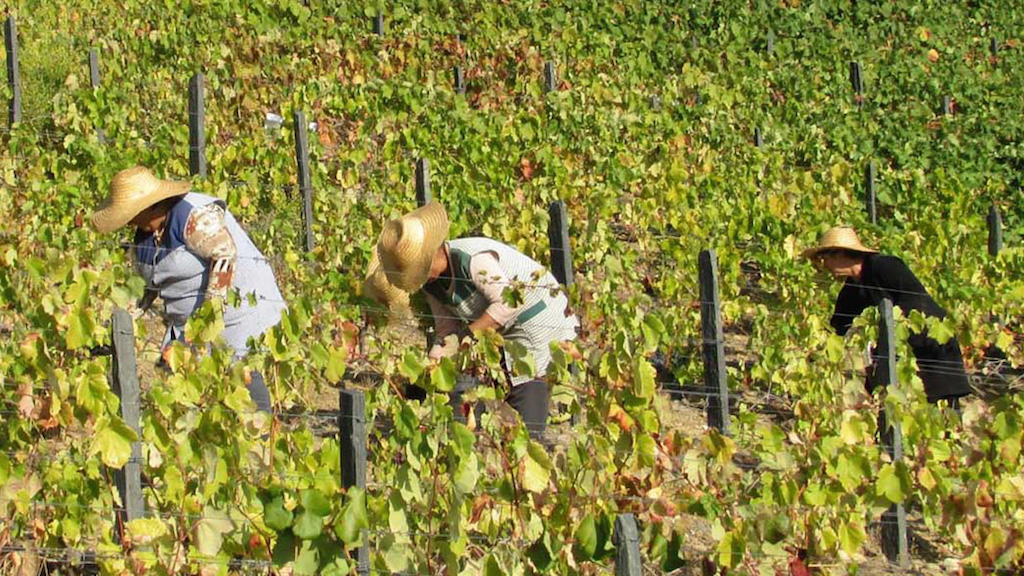
Portuguese grape varieties
Even though Portugal occupies little over 90.000 km², the diversity of vines accounts for more than 250 grape varieties when it comes to indigenous types. If you were to take into account the imported grape varieties which are now also widely cultivated in Portugal, it’s easy to understand that there is certainly no lack of diversity when it comes to flavor profiles and characteristics. If we compare this to other territories around the world, this number becomes even more astonishing. In the USA, for example, 80% of the wine comes from less than 10 grape varietals.
If Portuguese wines are so versatile is indeed because of a combination of differentiating terroirs across the map, in combination with this incredible choice of varietals.
These are some of the most popular native grape varieties in Portugal.

Below we list some of the most popular native grape varieties in Portugal.
Portuguese red grapes for vinho tinto
Alfrocheiro Preto
The most used grape variety in the Dão region, known for its deep color.
Alicante Bouschet
A cross between Petit Bouschet and Grenache, mostly cultivated in the Alentejo.
Aragonês
Mostly used for table wines in Alentejo and as well in the Dão and Douro regions, where is known as Tinta Roriz (and is Spain as Tempranillo).
Baga
While also used in the Alentejo and Ribatejo, this grape is the star of the show in the Bairrada region.
Bastardo
An early ripening grape used extensively in the Douro and Dão regions.
Moscatel Galego Roxo
Used in Setúbal Peninsula to produce fortified wine, with the same name.
Tinta Barroca
One of the most ancient grape varieties to be grown in the Douro, used as one of the blender grapes for most Port wines.
Tinta Caiada
Widely used in the Alentejo, in the production of wines to be drunk at a young age.
Tinta Negra
The main grape grown in Madeira island, used for the popular Madeira fortified wine. It is currently used in the island to produce still wines too by a young generation of innovative winemakers.
Touriga Franca
Also known as Touriga Francesca, it accounts for over 20% of all plantations in the Douro.
Touriga Nacional
One of the star grapes of Portugal, it’s one of the main grapes grown in the Dão and Douro Valley, yet considered noble nationwide.
Portuguese white grapes for vinho branco
Antão Vaz
Acidic and citrusy grape grown in the Alentejo.
Alvarinho
Grown and used in the north of Portugal for making Vinho Verde.
Arinto
Also referred to as Arinto de Bucelas, as it is mostly grown around this region in Lisbon, to be used in the production of fruity dry white wines.
Códega
Sometimes also called Roupeiro, it’s an ancient grape variety popular for the production of low acidity wines.
Encruzado
Used mostly in the Dão region for the production of wines that tend to age well.
Fernão Pires
Known as Maria Gomez in Bairrada, this aromatic grape reminisces of Muscat.
Loureiro
Used for Vinho Verde production, originally from the Lima Valley.
Malvasia Fina
Widely grown all over Portugal, this aromatic grape is used for different types of wine, including Port.
Moscatel de Setúbal
Cultivated way back in the day, during the times of the Roman Empire in the Iberian Peninsula, over 2000 years ago.
Sercial
The most popular white grape used in Madeira for the production of fortified wine.
Trajadura
Used for Vinho Verde wines with low acidity and high alcoholic content.
Verdelho
A noble grape variety grown mostly in the island of Madeira.
While in many parts of the world the most popular wines are single varietals, that is, wines made with just one type of grape, in Portugal the most common winemaking practices focus on blended wines, that is, wines made with a combination of at least two different grapes, but commonly even more than that.
Portuguese winemakers have been perfecting the art of wine blending for centuries, believing that the greatest qualities from Portugal’s wine are indeed expressed best when in combination rather than via single use of a given grape varietal. If with more than 250 native grapes was easy to picture you’d have plenty of opportunities to taste different wines, with blending techniques things get even more interesting, and virtually never-ending!
Quality and labeling of Portuguese wine
Before we start exploring the 13 different Portuguese wine regions, we’d like to take a quick look into how bottled wine is stamped in Portugal. According to quality, Portuguese wine is labeled into 3 categories:
DOC (in Portuguese DOP) – Denominação de Origem Controlada stands for high quality wines that have been produced in a specific region, following the cultivation and wine production rules specified by the wine authorities of that given area. There are 31 DOC regions across Portugal.
Vinho Regional or IGP – wines with a variety of grapes and blends that haven’t made it to the DOC variety are grouped under the regional wines category. But just because they aren’t as tightly controlled, that doesn’t mean you should necessarily expect less quality.
Vinho (simply wine) – stands for table wine and it’s the most basic labeling for wine in Portugal.
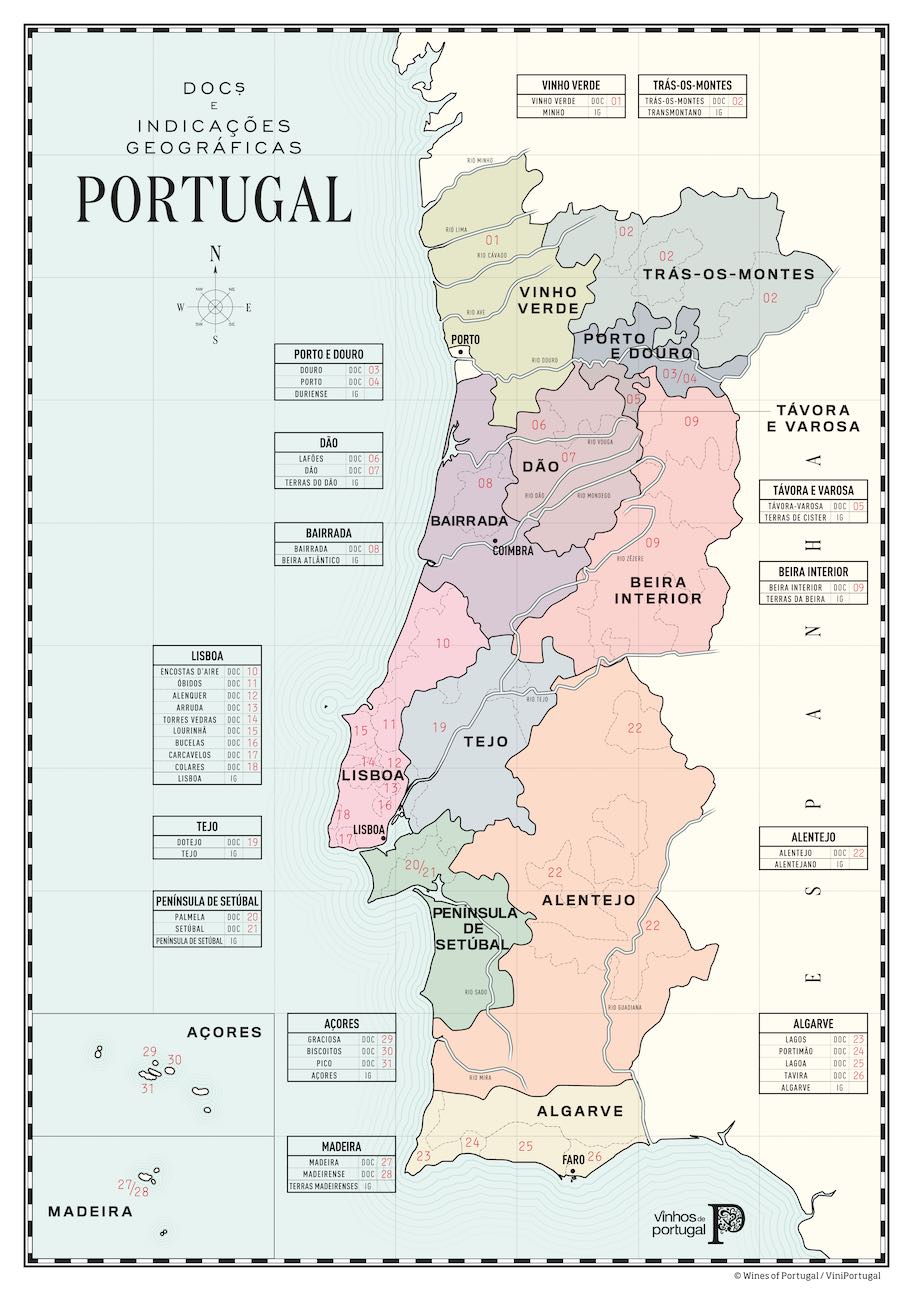
Portuguese wine regions
From north to south, and including the Atlantic archipelagos of Azores and Madeira, Portugal counts 13 different wine regions.
Vinho Verde
The northern Minho region is the home of Portugal’s favorite wine during summer. Even though its name translates as “green wine”, Vinho Verde can be white, red or rosé, and it stands for an acidic and slightly fizzy wine produced in the region that goes by the same name. The wines produced in the Vinho Verde region take their personality from the nearby Atlantic, and the abundant rainfall and cold temperatures this part of Portugal is (in)famous for.
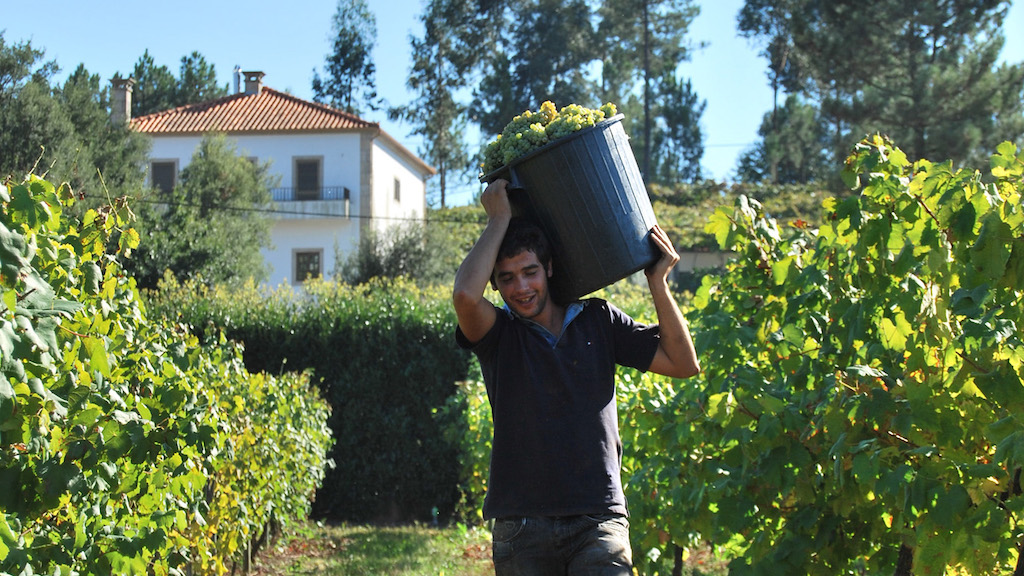
Trás-os-Montes
The territory to the interior of Portugal neighbouring the coastal region of Minho goes by the name of “beyond the mountains”. In this arid mountainous region of Portugal, there are three wine sub-regions: Chaves, Valpaços and Planalto Mirandês. Even within Portugal this is still one of the least explored wine regions of the country, but produces plenty of interesting wines that deserve to be explored.
Douro
Thanks to the worldwide popularity of Port wine, Douro is the most well-known wine region of Portugal. Not only is this one of the oldest wine-growing regions in the world, it’s also one of the oldest origin-protected wine regions globally, having gained that status back in the 17th century. Since 2001, Douro has also been protected by UNESCO as World Heritage. Labels aside, the Douro river runs its course from Spain towards the Atlantic, and the shores of its 100Km in Portugal are home to some of the country’s most fruitful vineyards. Douro is the birthplace of Port wine, but there’s much more to be explored around here! Don’t underestimate the red and whites from this region, and even other fortified wines such as Moscatel.
Távora and Varosa
The particular soil conditions and harsh climate of this small region make it unique and special for wine production. The terrains are known to be dry, mostly granitic and with limestone, and associated with the dry temperate weather create the conditions for the production of wines with intense aromas and natural acidity, that tend to age well over time. Távora and Varosa are mostly known for the production of sparkling wines, including Portugal’s first DOC sparkling wine that gained that status in 1989.
Dão
If you are into well-structured wines that are known to age well, we invite you to try some wine from Dão. Here vineyards are planted in rough terrains at high altitudes. Dão wines are known for their robust character, strong in tannins. The most popular wines to come out of Dão are by far reds produced with Touriga Nacional grapes, even though the region also has incredible whites and rosés that would be a mistake to ignore.
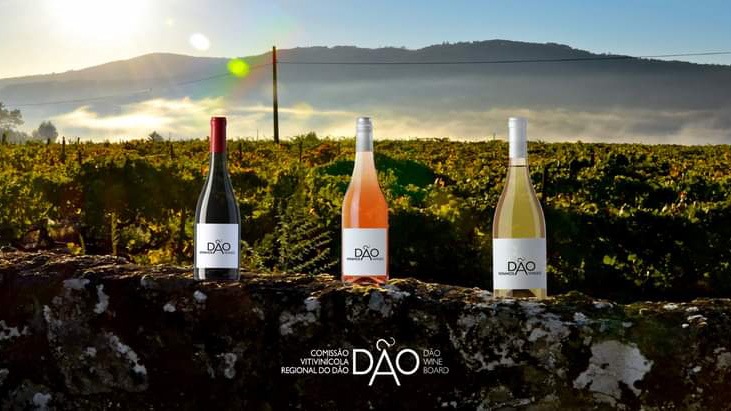
Bairrada
This region in the Beira Litoral province of Portugal is known for the extensive use of the red grape variety Baga. With this and other grapes, Bairrada produces rich wines with deep red color and hints of blackberry. The humidity and cool coastal temperatures of this region aid in the growth of grapes to make wines with low alcoholic content and of high acidity.
Beira Interior
This up-and-coming wine region is slowly, but steadily, making a name for itself in the world of Portuguese wines. The sparkling wines from this region are notable, but there’s more than bubbles to be sampled around here. While Portuguese grapes are the star of the show in Beira Interior, the region is also known to create noteworthy blends of local varieties with internationally popular grapes such as Cabernet Sauvignon, Merlot, Chardonnay, Syrah and Riesling.
Lisbon
Lisbon region is known for producing affordable wines with many different profiles. Keep an eye out for the deep reds from Alenquer, the whites from Bucelas that age beautifully, the well structured reds from Arruda or the refreshing low alcohol whites from Torres Vedras, Óbidos and Lourinhã. Full-bodied white wine from Colares, produced with Malvasia Fina grapes grown in beach cliffs are a rare find – so if you come across it, you know what to do!
Tejo
Maintaining vineyards in this semi-arid region around the Tagus river near Lisbon isn’t always an easy task. Tejo wine region was named from Ribatejo to Tejo in 2009, and it includes the area of the Ribatejo province, just inland from Lisbon. There’s a wide range of grapes being cultivated in this region and the wines aren’t always highlighted as the most unique in Portugal, but tend to represent good value for money and are certainly worth exploring for those interested in understanding the variety of wines across Portugal.
Península de Setúbal
Bringing together the Designations of Origin Palmela and Setúbal, the regional wines of Península de Setúbal are quite remarkable in the Portuguese wine panorama. This Portuguese wine region is particularly significant for the production of dessert wines Moscatel and Moscatel Roxo. Palmela and Setúbal have a variety of vineyards and cellars open to the public, where you can understand more about wine making and indulge in a tasting. If you’d like to visit some of the best wineries close to Lisbon, ask us how.
Alentejo
The Alentejo accounts for one third of Portugal’s map and is the place where a lot of the food and wine consumed in our country comes from. If you go out for a glass of wine around Lisbon and ask for your waiter’s recommendation, chances are you’ll end up drinking Alentejo wine. The temperatures and soils around the Alentejo vary, from coastal to interior, to temperate to fiercely hot, and so do the profiles of the wines produced in this region. Alentejo has been a demarcated wine region since 1988 and it has 8 different sub-regions: Reguengos, Borba, Redondo, Vidigueira, Évora, Granja-Amareleja, Portalegre and Moura. The most relevant red grape varieties in this region are Alicante Bouschet, Aragonez and Trincadeira, while the white varieties that stand out are Antão Vaz and Arinto. So much diversity results into one thing: lots and lots to be tasted and explored!
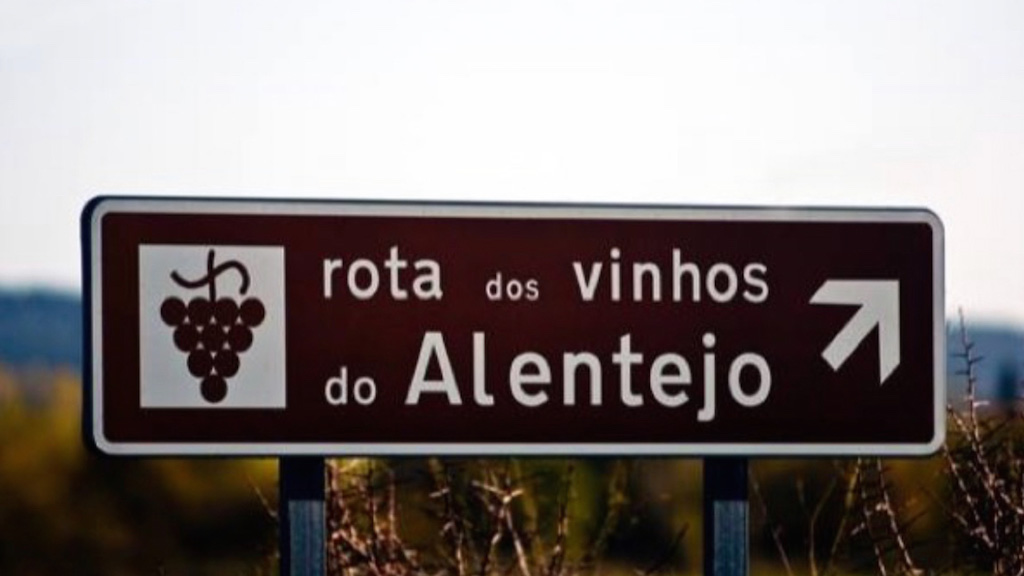
Algarve
Portugal’s sun and beach mecca is also home to some wines, particularly reds produced with grapes such as Alicante Bouschet, Aragonês and Syrah. Due to the intensely hot climate, the wines produced here are best drunk rather young and don’t age particularly well. Expect aromatic and smooth wines with slightly sweet and smoky notes.
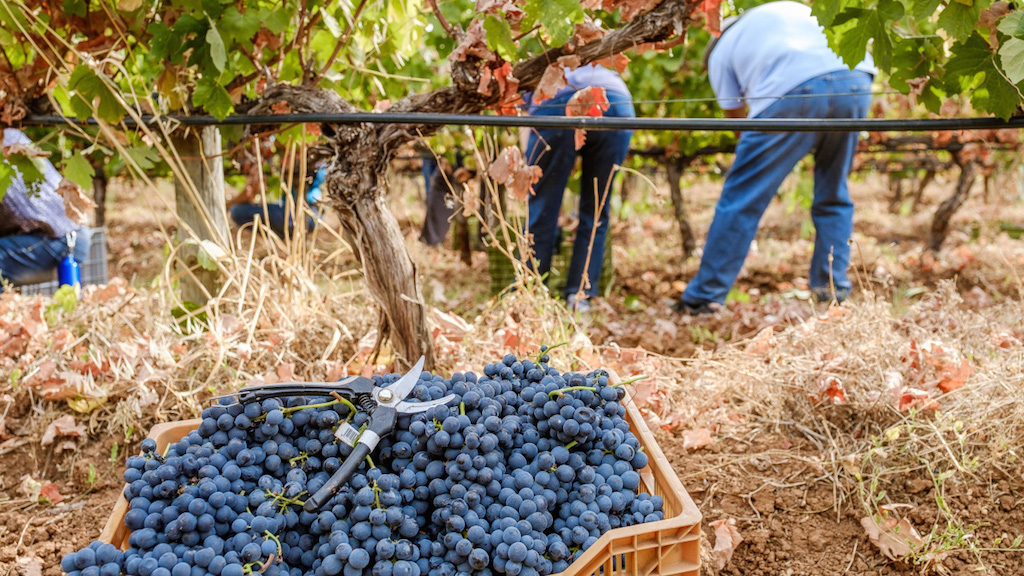
Madeira
After Port, Madeira is not only Portugal’s most famous fortified wine, but also one of the most appreciated fortified wines all over the world. Due to its remoteness and difficulty of cultivation in rugged soils, the production of Madeira wines comes at a fairly high price, probably contributing even more to its popularity and desirability. Keep in mind that Madeira fortified wine is not the only type of wine being produced in Madeira. While the fortified varieties are marketed as Madeira DOC, other regional wines are also produced and sold under the label Terras Madeirenses.
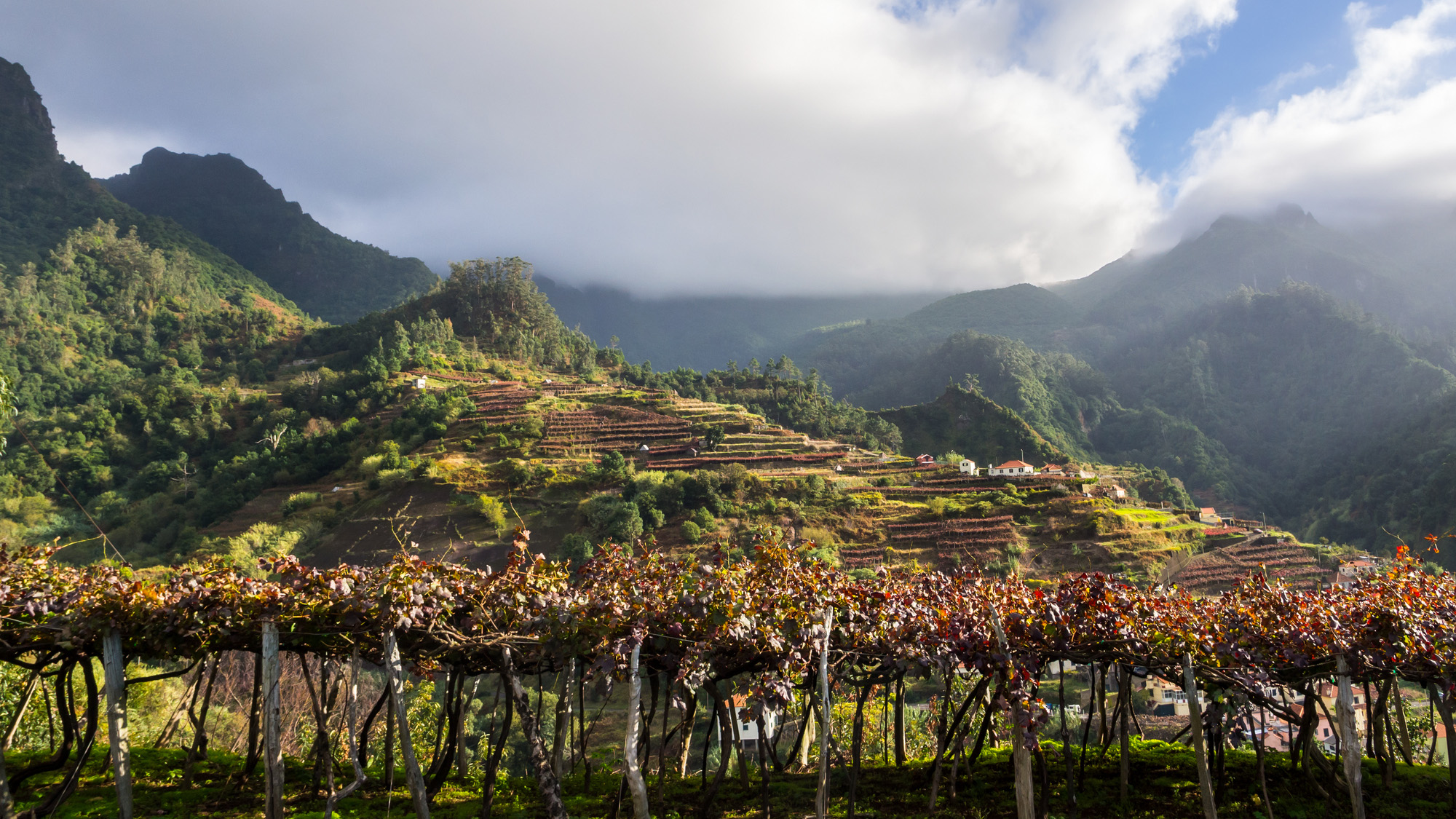
Azores
Located in the Atlantic ocean, more than 1500km from mainland Portugal, The Azores are a Portuguese archipelago with nine islands, of which three cultivate grapes for wine making. The islands of Terceira, Pico and Graciosa are responsible for one of Portugal’s less explored and thus most exciting wine regions. The white wines from Pico, a volcanic island where the highest point of Portugal is located, are particularly appreciated by wine experts. The volcanic soil, surrounded by the saltiness of the ocean, contributes to wines that are tart yet sweet, with a hint of saltiness and faint smokiness. These are places and wines like no other!
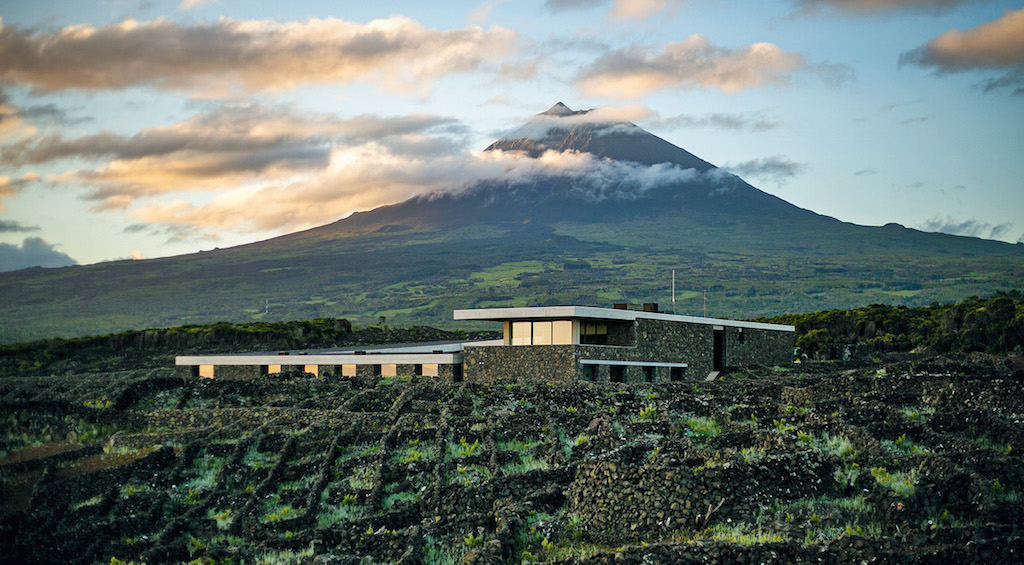
Have you tried Portuguese wines before? We’d love to know more about your experiences! Send us your comments (or questions!) via Facebook or Instagram. Please tag @tasteoflisboa #tasteoflisboa
We’ll love to see your photo shoots, to know about your insights, questions, suggestions and wishes on your food & culture experiences in Lisbon and Portugal. Please share with us via Facebook, Instagram or Twitter and tag us @tasteoflisboa or #tasteoflisboa.
Feed your curiosity on Portuguese food and wine culture:
The Four fortified wines from Portugal
Azores and Madeira: discover the wines from the Portuguese islands
10 typical drinks from Portugal
Foods you didn’t know were Portuguese
9 Portuguese snacks and wine pairings that will surprise you
Real people, real food. Come with us to where the locals go.
Signup for our natively curated food & cultural experiences.
Follow us for more at Instagram, Twitter e Youtube
